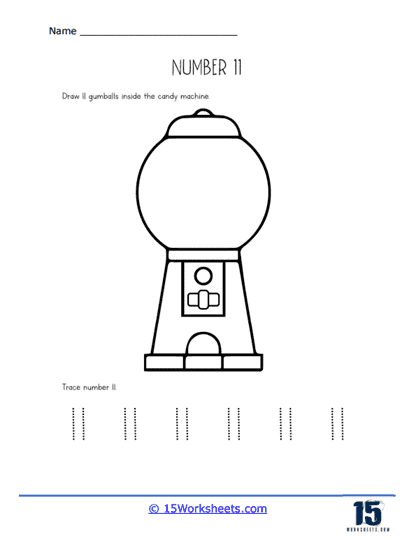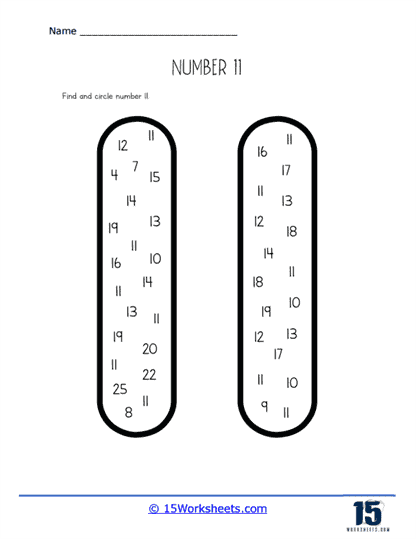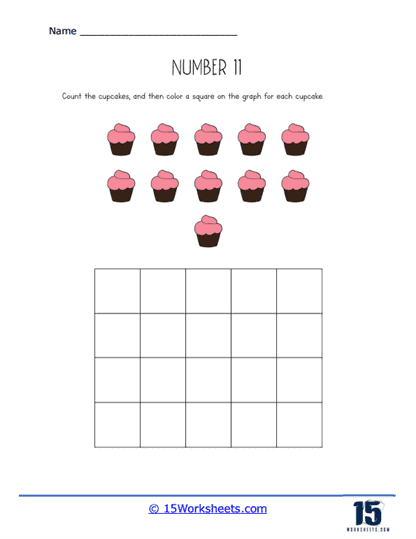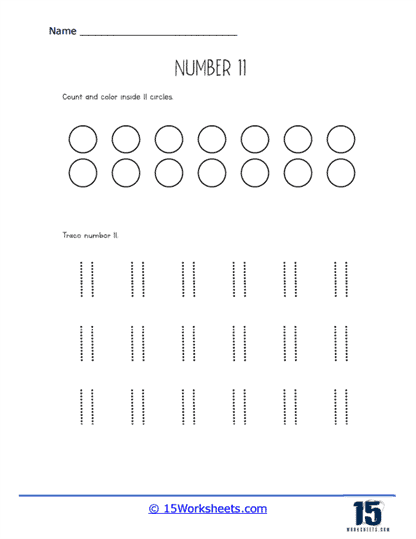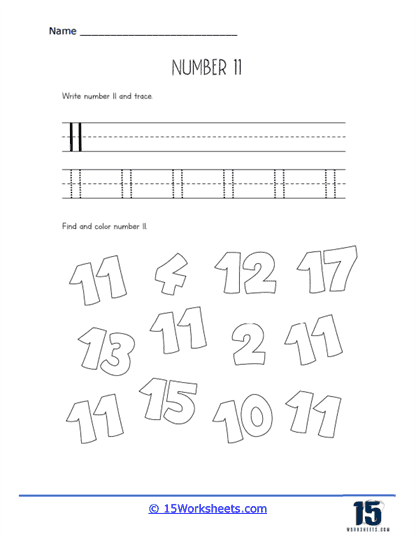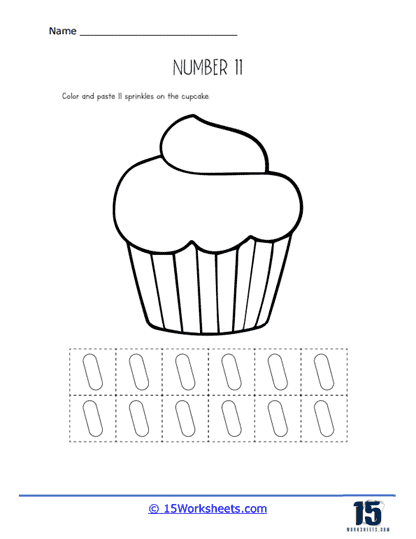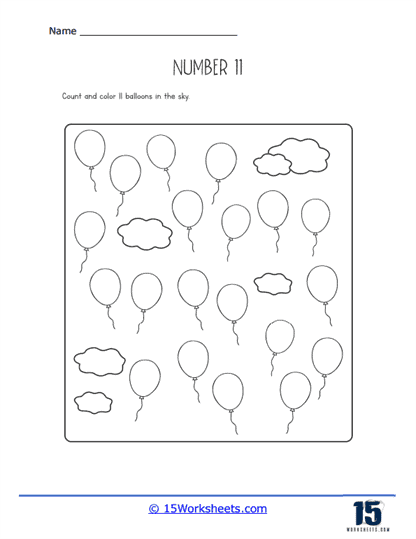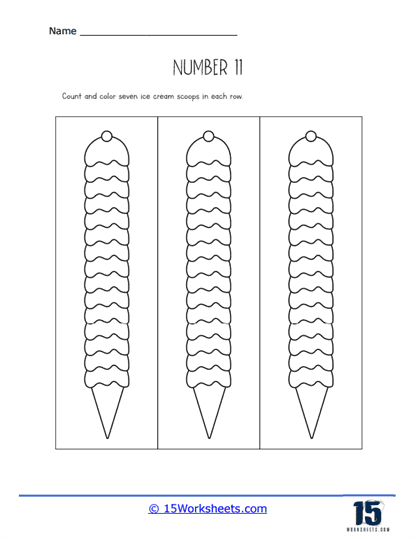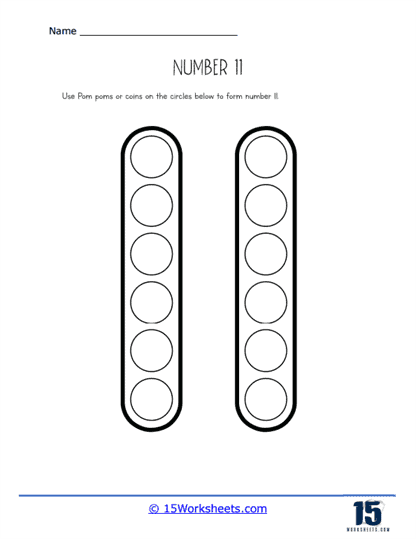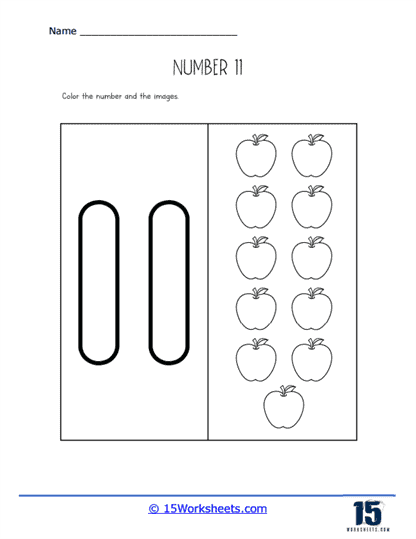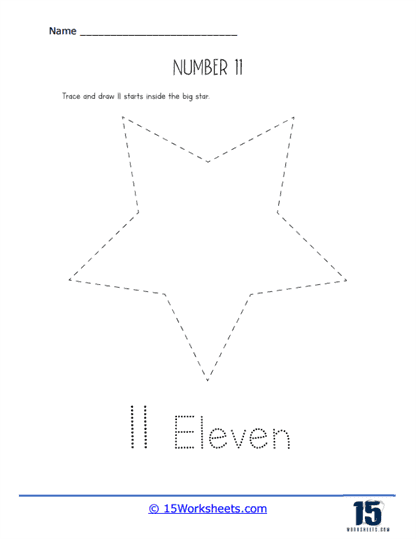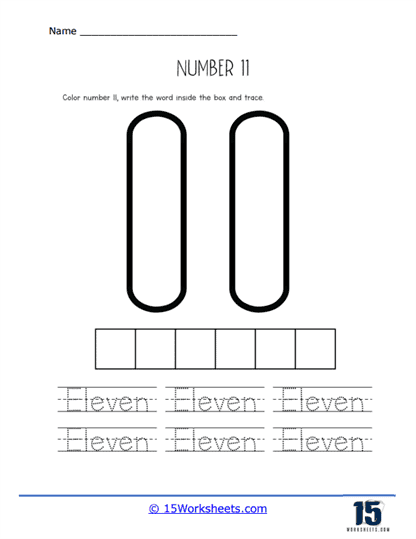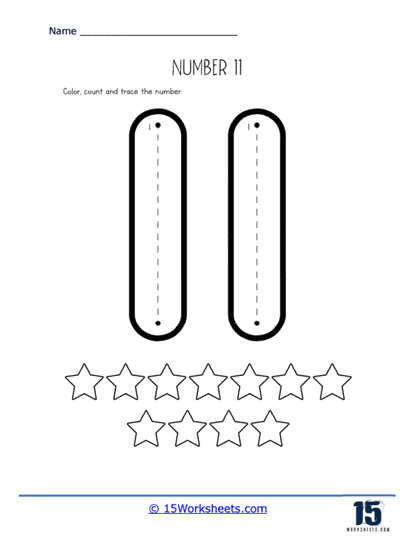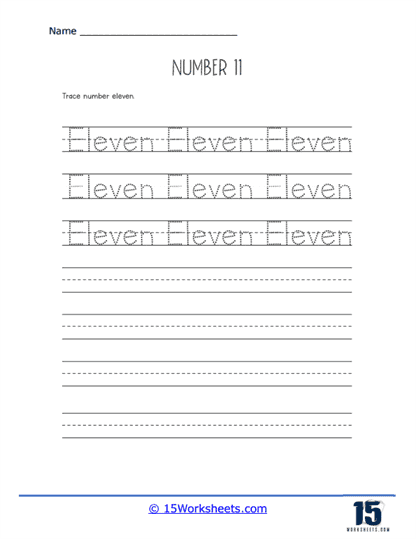Number 11 Worksheets
About These 15 Worksheets
Imagine embarking on an exciting journey, where your guide is a simple yet powerful tool: a collection of worksheets focused on the number 11. These are not just ordinary worksheets filled with routine tasks; they are interactive experiences designed to take you on an engaging adventure through the world of numbers. With every stroke of your pencil, carefully counted object, and vivid splash of color, you’re doing more than just learning about the number 11-you’re truly experiencing it. Each task becomes a stepping stone toward unlocking the hidden potential of this seemingly straightforward number, equipping you with valuable skills that will stay with you far beyond the page.
From the very first task, the worksheets captivate your attention with interactive, hands-on activities. You might start by tracing the number 11, guiding your hand along the curves of each digit as you become more familiar with its form. Before you know it, you’ll be coloring balloons-exactly eleven of them-each one representing a small but significant step toward mastering this number. Or perhaps you’ll find yourself counting kittens in a yard-eleven of the most playful kittens imaginable. As you explore further, you’ll discover that the number 11 is cleverly hidden among other numbers, waiting to be found like a hidden treasure. These activities are not only fun but also purposeful, making learning feel less like work and more like a captivating game. As with learning the alphabet, each task builds a deeper understanding, helping you grasp the significance of the number 11 in the same way letters unlock the world of reading.
Numbers, much like words, form a universal language. Just as every letter plays a crucial role in building language, every number is essential to understanding math. These worksheets go beyond simple recognition and delve into a deeper concept known as “number sense.” While the term might sound technical, think of it as your innate ability to understand and work with numbers. It’s like a superhero power in the world of math. With strong number sense, you can confidently navigate numbers, understanding their relationships and how they behave in different scenarios. Much like a superhero knows how to use their abilities instinctively, developing number sense allows you to tackle mathematical challenges with ease and confidence.
Every worksheet activity is a small but meaningful step toward strengthening your number sense. When you trace or write the number 11 repeatedly, you’re training your brain to recognize it instantly, much like recognizing a familiar face in a crowd. The more you practice, the more second nature it becomes. But these worksheets don’t stop at just recognizing the number-they take you further. As you color or count eleven objects, whether they’re puppies, stars, or apples, you’re learning to connect the number “11” with its real-world quantity. It’s a bit like putting together a puzzle, where each piece helps complete the larger picture of how numbers shape the world around you.
In addition to developing an understanding of the number 11, these worksheets also enhance an essential life skill: numeracy. Numeracy goes far beyond simply learning math in a classroom-it’s the ability to apply math in real-life situations. Imagine you have eleven candies, and you eat two. Instinctively, you know that you’re left with nine candies. That’s numeracy in action, and it’s exactly what these worksheets help you practice. In one exercise, you might color a few stars out of a group of eleven and then figure out how many are left. Without realizing it, you’re practicing subtraction, sharpening your problem-solving skills in a fun and engaging way. These worksheets don’t just teach numbers-they make math relevant and practical, bringing it to life.
What sets these worksheets apart is how they turn learning into a joyful and memorable experience. Each task feels like play-whether you’re tracing numbers, counting objects, or searching for hidden digits. The vibrant visuals, such as pictures of objects arranged in groups of eleven, make the concept of “eleven” tangible and easy to grasp. You’re not just memorizing the number; you’re visualizing it, interacting with it, and internalizing it in a way that sticks. This playful approach keeps you engaged and motivated, transforming what could be a tedious exercise into an exciting quest for knowledge.
As you progress through the worksheets, you’re not just learning about the number 11-you’re improving your overall math skills, often without even realizing it. The enjoyment of the activities encourages you to keep going, fostering a sense of curiosity and eagerness to explore more. When learning is fun, it’s not only more effective but also longer-lasting. The joy you find in these tasks ensures that the knowledge you gain becomes a part of your skill set, making math feel less like a chore and more like an enjoyable challenge.
Fun Facts About Number 11
The number 11 is often viewed as a symbol of power, mystery, and spiritual significance, and for good reason. In numerology, it is considered a “master number,” a term that immediately elevates its status beyond ordinary digits. Master numbers are thought to resonate with heightened spiritual awareness and potential, and 11 is particularly associated with intuition, insight, and enlightenment. Those who find themselves constantly encountering the number 11 might see it as a sign to tap into their inner wisdom and listen to their instincts. Many believe that 11 embodies a bridge between the physical world and a higher spiritual realm, urging us to seek deeper truths and understand our purpose in a more meaningful way.
Mathematically, 11 stands out in several ways. In the modern decimal system, it is the second prime number after 7, making it part of an exclusive group of numbers that are divisible only by 1 and themselves. Prime numbers hold a special place in mathematics due to their foundational role in number theory, and 11, with its simplicity and indivisibility, holds a quiet power that many overlook. In binary, a language central to computing, the number 11 is represented as 1011, which further demonstrates its symmetry and balance. Interestingly, 11 is also palindromic in both decimal and binary form, meaning it reads the same forwards and backwards—a rarity that adds to its allure. This symmetry reflects the harmonious nature that 11 is often thought to embody, whether in mathematics or in spiritual beliefs.
Historically, the number 11 has appeared at crucial moments in human events. One of the most significant instances is the conclusion of World War I, which officially ended on the 11th hour of the 11th day of the 11th month in 1918. This convergence of 11s is more than just coincidence; it has become a symbol of peace and remembrance. Today, countries such as the United States commemorate Veterans Day on November 11, honoring the sacrifices made by soldiers, while many Commonwealth nations observe Remembrance Day at the same time. The repetition of the number 11 in this context adds a layer of solemnity and reverence, reminding us that some numbers carry deep emotional resonance.
The realm of space exploration has also seen the number 11 shine. On July 20, 1969, the world watched in awe as Apollo 11 became the first manned mission to land on the Moon, forever etching the number in human history. The phrase “one small step for man, one giant leap for mankind” became a symbol of what humanity can achieve when we dare to reach beyond our known boundaries. The success of Apollo 11 is more than just a milestone in space exploration—it is a testament to the power of determination, innovation, and vision. When we think of 11 in this context, it reminds us that the impossible is often just a matter of pushing past the boundaries of the possible.
In the natural world, 11 holds fascinating significance as well. Honeybees, critical to the planet’s ecosystem, follow an 11-day lifecycle from the egg stage to becoming a worker bee. This precise timing underscores the number’s connection to life cycles, growth, and the intricate patterns of nature. These small but mighty creatures, whose existence is vital for pollination and agriculture, reflect the delicate balance that exists in the natural world—one that, much like the number 11 itself, is full of symmetry and order.
Even in ancient civilizations, the number 11 was viewed with a sense of reverence. The 11th day of each month was often considered a time of spiritual significance, a moment to pause and reflect. These societies understood the cyclical nature of time and the importance of aligning themselves with the universe’s rhythms. Whether or not they could explain it mathematically, they sensed the power of numbers like 11 and built rituals around them. Today, some people still hold fast to these ancient beliefs, believing that when 11 appears in their lives, it serves as a call to focus on their spiritual path.
In modern culture, the phrase “once in a blue moon” adds to the number 11’s intrigue. The phrase refers to the rare occurrence of two full moons in a single month, an event that happens approximately every 2.7 years, or around 11 times in 30 years. This rarity gives the number 11 a sense of magic and rarity, a reminder that extraordinary events, though infrequent, do happen.
Symbolically, the number 11 even makes its way into iconic structures. The Statue of Liberty, one of the most recognized symbols of freedom in the world, has 11 points on her crown, each representing a gem of wisdom. These points symbolize the spread of enlightenment and the importance of shared knowledge. They remind us that freedom, like wisdom, is something that must be pursued and protected with care.
The natural world also gives us another powerful connection to 11 through the Siberian tiger, the largest cat species on Earth. These majestic creatures can grow up to 11 feet in length, a testament to their strength and dominance in the animal kingdom. The Siberian tiger’s sheer size and power reflect the number 11’s association with greatness and leadership.

